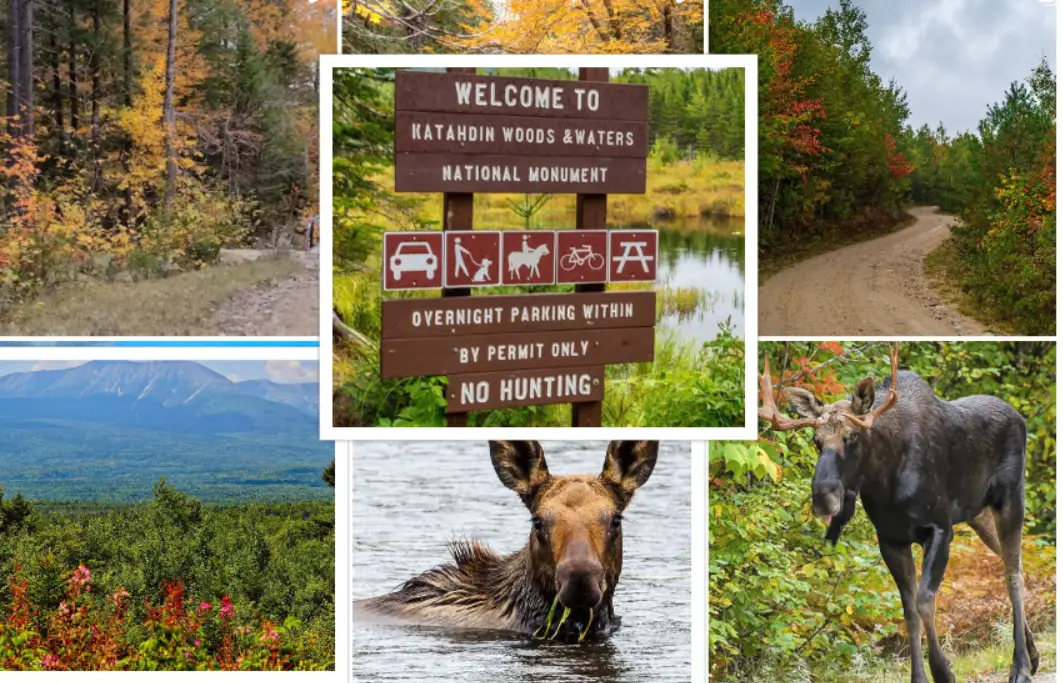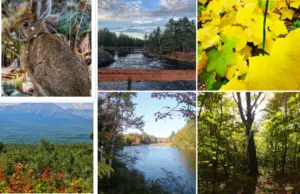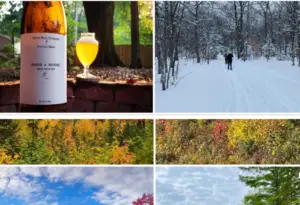Katahdin Woods and Waters National Monument : Interesting Facts, History & Travel Guide

- By
- Aparna Patel
- |
- 11 Apr, 2023
- |

Welcome to our blog post about Katahdin Woods and Waters National Monument, a hidden gem in northern Maine. In this post, we’ll explore the interesting facts, rich history, and practical travel guide for visiting this unique destination. From hiking and camping to fishing and wildlife viewing, there’s something for everyone at this stunning natural wonder.
So, whether you’re planning a trip or just looking to learn more about this national monument, read on to discover all that Katahdin Woods and Waters has to offer.
Table of Contents
Interesting facts about Katahdin Woods and Waters National Monument
- Katahdin Woods and Waters National Monument covers an area of over 87,500 acres and includes part of the East Branch of the Penobscot River.
- The monument was established by President Barack Obama in August 2016, using the powers granted to him under the Antiquities Act of 1906.
- The monument is located near Mount Katahdin, the highest mountain in Maine and the northern terminus of the Appalachian Trail.
- The land that now comprises the monument was donated to the National Park Service by the Quimby family, who made their fortune in the clothing industry.
- The monument is home to a wide variety of wildlife, including moose, black bears, coyotes, and bald eagles.
- Visitors to the monument can enjoy a range of recreational activities, including hiking, fishing, camping, and canoeing.
- The monument is managed by the National Park Service in partnership with the Katahdin Woods and Waters Recreation Area Foundation, a nonprofit organization that works to support the monument and promote its use.
- The monument is located in an area that has long been important to the Penobscot Nation, a Native American tribe that has lived in the region for thousands of years.
- The monument includes the remains of several historic logging camps and other sites that provide a glimpse into the history of the region.
- Despite being a relatively new national monument, Katahdin Woods and Waters has already become a popular destination for outdoor enthusiasts and nature lovers from around the world.
Read More:
- Kasha-Katuwe Tent Rocks : Interesting Facts, History & Travel Guide
- Utah – Jurassic National Monument : Interesting Facts, History & Travel Guide
- John Day Fossil Beds : Interesting Facts, History & Travel Guide
- Jewel Cave National Monument : Interesting Facts, History & Travel Guide
Information & History of Katahdin Woods and Waters National Monument
Katahdin Woods and Waters National Monument is a US national monument located in the state of Maine, established on August 24, 2016, by President Barack Obama using the powers granted to him under the Antiquities Act of 1906. The monument is managed by the National Park Service and covers an area of over 87,500 acres.
The land that comprises the monument was donated to the National Park Service by the Quimby family, who made their fortune in the clothing industry. The family had been purchasing land in the region for over two decades with the goal of creating a protected wilderness area. The monument includes part of the East Branch of the Penobscot River, a major tributary of the Penobscot River, and is adjacent to Baxter State Park, which includes Mount Katahdin, the highest mountain in Maine and the northern terminus of the Appalachian Trail.
Katahdin Woods and Waters National Monument is home to a diverse range of flora and fauna, including moose, black bears, coyotes, and bald eagles. The region has a long history of human use, with Native American tribes, French explorers, and later, European settlers using the land for hunting, fishing, and logging. The monument includes the remains of several historic logging camps and other sites that provide a glimpse into the history of the region.
The establishment of Katahdin Woods and Waters National Monument was not without controversy. Some local residents and politicians were concerned about the potential impact of the monument on the region’s economy, which has traditionally been driven by logging and other resource extraction industries. However, supporters of the monument argue that it will bring new economic opportunities to the region by attracting tourists and outdoor enthusiasts.
Today, visitors to the monument can enjoy a range of recreational activities, including hiking, fishing, camping, and canoeing.
The monument is managed by the National Park Service in partnership with the Katahdin Woods and Waters Recreation Area Foundation, a nonprofit organization that works to support the monument and promote its use.
Despite being a relatively new national monument, Katahdin Woods and Waters has already become a popular destination for outdoor enthusiasts and nature lovers from around the world.
Travel Guide for Katahdin Woods and Waters National Monument
- When to go: The best time to visit the monument is during the summer months (June-August) when the weather is warm and dry. However, fall (September-October) is also a beautiful time to visit, with colorful foliage and cooler temperatures.
- How to get there: The monument is located in northern Maine, about a 3-hour drive from Bangor International Airport. There is no public transportation to the monument, so you will need to rent a car or arrange for a shuttle service.
- Where to stay: There are several campgrounds within the monument, as well as nearby accommodations in the towns of Millinocket and Patten. Reservations are recommended, especially during the summer months.
- What to do: The monument offers a variety of outdoor recreational activities, including hiking, fishing, camping, and canoeing. There are over 100 miles of trails in the monument, ranging from easy strolls to challenging hikes. The East Branch of the Penobscot River is also a popular spot for fishing and canoeing.
- Ranger-led programs: The National Park Service offers a variety of ranger-led programs, including guided hikes, campfire talks, and stargazing events. Check the park website for a schedule of events.
- Visitor center: The monument’s visitor center is located in the town of Patten and is open year-round. Here you can find maps, guidebooks, and information about the monument’s history and ecology.
- What to bring: Be sure to pack appropriate gear for your activities, including sturdy hiking boots, insect repellent, sunscreen, and plenty of water. It can get chilly at night, even in the summer, so bring warm layers.
- Respect the wilderness: Remember that you are visiting a wilderness area and should take care to leave no trace of your visit. Follow park rules and regulations, stay on designated trails, and pack out all of your trash.
Katahdin Woods and Waters National Monument camping
Katahdin Woods and Waters National Monument offers several camping options for visitors, including frontcountry and backcountry camping.
Frontcountry camping is available at two campgrounds within the monument: the Katahdin Woods and Waters Campground and the Lunksoos Campground. Both campgrounds have amenities such as picnic tables, fire rings, and vault toilets. Reservations are recommended, especially during the summer months, and can be made online or by phone.
Backcountry camping is also allowed within the monument, but requires a permit from the National Park Service. There are designated backcountry campsites along the International Appalachian Trail and other trails in the monument. Campers must follow Leave No Trace principles and pack out all trash.
In addition to camping, the monument offers other lodging options, such as cabins and lodges, which can be rented from private companies or organizations located near the monument. These accommodations vary in amenities and price, so it is best to do some research beforehand to find the option that best suits your needs.
Regardless of where you choose to stay, be sure to follow park regulations and guidelines to ensure a safe and enjoyable camping experience.
Katahdin Woods and Waters Things to do
- Hiking: The monument offers over 100 miles of hiking trails, ranging from easy walks to challenging treks. Some of the most popular trails include the Katahdin Loop Road Trail, the Deasey Mountain Trail, and the Wassataquoik Lake Trail.
- Fishing: The East Branch of the Penobscot River is a popular spot for fishing, with species such as brook trout and landlocked salmon. A Maine fishing license is required and can be purchased online or at local retailers.
- Canoeing and kayaking: The East Branch of the Penobscot River is also a great spot for canoeing and kayaking, with several put-in and take-out points within the monument.
- Wildlife viewing: The monument is home to a variety of wildlife, including moose, black bears, coyotes, and bald eagles. Be sure to bring binoculars and keep a safe distance from animals.
- Ranger-led programs: The National Park Service offers a variety of ranger-led programs, including guided hikes, campfire talks, and stargazing events. Check the park website for a schedule of events.
- Scenic drives: The Katahdin Loop Road offers a 17-mile scenic drive through the monument, with several pullouts and overlooks providing views of Mount Katahdin and the East Branch of the Penobscot River.
- Winter activities: The monument is open year-round and offers opportunities for cross-country skiing, snowshoeing, and winter hiking.
- Photography: With its stunning landscapes and diverse wildlife, Katahdin Woods and Waters National Monument is a great place for photography.
- Historical sites: The monument includes several historic sites, such as the Lunksoos Camps and the Haskell Deadwater Site, which provide a glimpse into the region’s history.
- Camping: As mentioned earlier, the monument offers frontcountry and backcountry camping options, as well as other lodging options like cabins and lodges.
Know More About USA
- Ironwood Forest National Monument : Interesting Facts, History & Travel Guide
- Hovenweep National Monument : Interesting Facts, History & Travel Guide
- Hohokam Pima National Monument : Interesting Facts, History & Travel Guide
- Harriet Tubman Underground Railroad National Monument : Interesting Facts, History & Travel Guide
Search Posts
Latest posts
-
4 Mar, 2024
How to make dining alone less awkward?
-
4 Mar, 2024
Can I accidentally miss the in-flight food?
